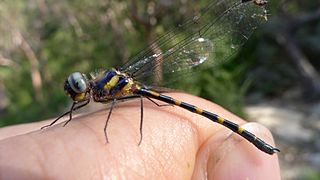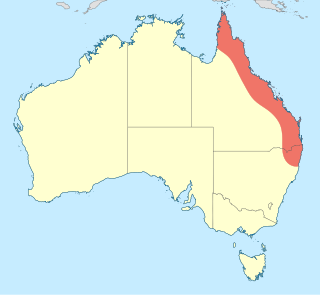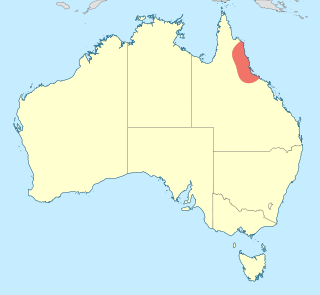
Austrocordulia is a genus of dragonfly in the superfamily Libelluloidea, endemic to northern and eastern Australia. Species of Austrocordulia are medium-sized, dark-coloured dragonflies, either brown or black with yellow markings.

Ictinogomphus is a genus of dragonflies in the family Gomphidae. They are medium to large, yellow and black with clear wings. Species occur in Africa, Asia and Australia.

Lathrocordulia is a genus of dragonfly in the superfamily Libelluloidea, endemic to Australia. Species of Lathrocordulia are medium-sized, bronze to black dragonflies without pale markings,

Archaeophya adamsi, commonly known as Adam's emerald dragonfly or horned urfly, is a species of dragonfly in the superfamily Libelluloidea. This is an Australian endemic and one of the rarest dragonflies in the country. It breeds in rivers and streams in coastal areas of Queensland and New South Wales.

The Synthemistidae are the family of dragonflies commonly known as tigertails, or sometimes called southern emeralds. This family is part of the superfamily Libelluloidea.

Coenagrionoidea is a superfamily of closed wing damselflies of the order Odonata found worldwide.

Libelluloidea is a superfamily of dragonflies.

Cordulephya is a genus of dragonflies assigned to the superfamily Libelluloidea, and endemic to eastern Australia. The species are small to tiny in size, coloured black, or purplish-black, with yellowish markings. Unusually for Anisoptera, these dragonflies rest with their wings folded above their body in a similar manner to many species of damselfly. They are commonly known as shutwings.
Cordulephyidae was formerly considered a distinct family of dragonflies occurring in Africa and Australia. Recent taxonomic revisions have classified the species previously placed in Cordulephyidae to now be within the superfamily Libelluloidea.
Up until recently, Lindeniidae was considered a family of dragonflies occurring in Australia. It is no longer recognised.
Brachytronidae was formerly considered a distinct family of dragonflies occurring in Australia. Up until recently, Dendroaeschna had been its only genus, and that is now placed in the family Aeshnidae. Brachytronidae is no longer recognised.
Austrocorduliidae was formerly considered a family of dragonflies occurring in South Africa and Australia. Recent taxonomic revisions have classified the species previously placed in Austrocorduliidae to now be within the superfamily Libelluloidea.

Apocordulia is a genus of dragonflies in the superfamily Libelluloidea, endemic to the Murray-Darling Basin in eastern Australia.

Hesperocordulia is a genus of dragonflies in the superfamily Libelluloidea, endemic to south-western Australia.

Micromidia is a genus of dragonflies in the superfamily Libelluloidea. They are small to medium-sized dragonflies, coloured black or metallic green with pale markings, and endemic to eastern Australia.

Micromidia rodericki is a species of dragonfly in the superfamily Libelluloidea, known as the Thursday Island mosquitohawk. It is a very small, black to metallic green dragonfly with pale markings on its abdomen. It is endemic to Thursday Island, Australia, in Torres Strait, where it inhabits rainforest streams.

Austrophya is a genus of dragonflies in the superfamily Libelluloidea, endemic to north-eastern Australia.
Gomphomacromiidae was formerly considered a distinct family of dragonflies occurring in Chile and Australia. Recent taxonomic revisions have classified the species previously placed in Gomphomacromiidae to now be within the superfamily Libelluloidea.

Archaeophya magnifica is a species of dragonfly in the superfamily Libelluloidea, known as the magnificent urfly. It is a large, metallic-black dragonfly with yellow markings and clear wings. It is endemic to north-east Queensland, Australia. where it inhabits rainforest streams.

Pseudocordulia is a small genus of dragonflies endemic to tropical north-eastern Australia. They are medium-sized, bronze-black dragonflies with clear wings.















